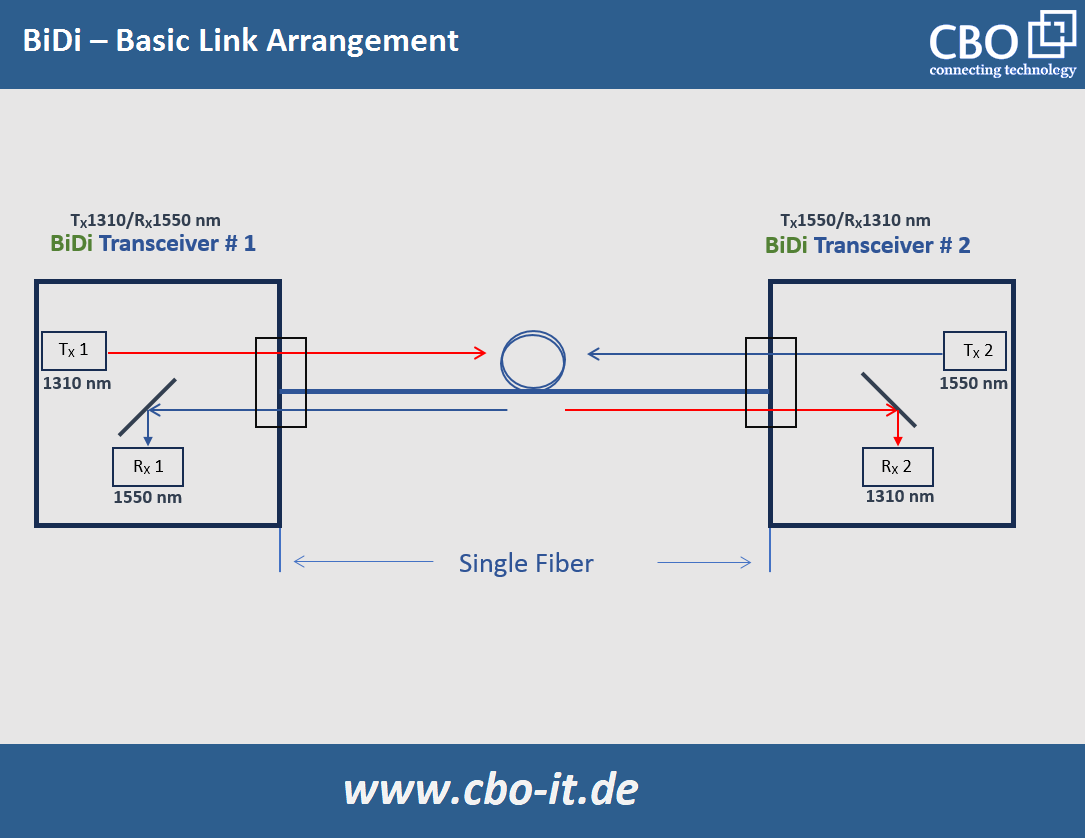BiDi or "bidirectional modules" are compact optical modules that utilize WDM technology and are designed to comply with the SFP multi-source agreement. Bi-directional technology refers to a communication mode where data transmission (sending/receiving) occurs simultaneously in both directions over an optical fiber cable. Bi-directional data transmission enables transceivers to send and receive data from the connected devices over a single cable.
How do BiDi Modules Work?
BiDi or "bidirectional modules" come with integrated WDM couplers/diplexers to merge or demerge data packets transmitter over a single optical fiber cable using different wavelengths. Like other optical transceivers, bidirectional ones should also be deployed in pairs. In a network constructed with BiDis, we use one module for the upstream direction and another for the downstream direction. These modules are configured to operate at a wavelength opposite to one another.

For a better explanation, let us proceed with a practical example! Consider we have a link (A to B) consisting of two bidirectional transceivers, A and B. In this case, transceiver A transmits at 1310nm, and transceiver B transmits at 1490nm. For reception, transmitter A utilizes 1490nm, whereas transmitter B utilizes 1310nm. Thus, transceivers A and B will join networking to send and receive data simultaneously.
Common Bidi Types
There are many Bidi transceiver options available on the market today. However, the 1G and 10G Bidi (bidirectional) SFPs are the most popular. Typical light wavelength pairs for the transmission and reception of data through 1G/10G bidirectional SFP modules are 1310/1550nm,1490/1550nm, and 1310/1490nm. Bidi modules for 1G or 10G deployments are viable for long-distance links up to 80 kilometers. Besides SFP, we also have bidirectional transceivers available in other form factors, such as XFP and GIBC, for 10G and 1G connectivity, respectively.
Bidi for longer reach!
The 25G SFP28 BiDi transceiver is designed to facilitate connections over a distance of up to 10 kilometers over single-mode fiber (SMF), and it utilizes LC connectors for ease of use. This transceiver uses 1330nm for transmission and 1270nm for reception.
BiDi for higher bandwidth
The 100G QSFP28 BiDi CWDM4 transceiver is an excellent choice for those requiring even higher bandwidth. It supports connections over single-mode fiber up to a distance of 2 kilometers and also features LC connectors for seamless connectivity. The wavelengths supported by this transceiver are 1271 nm, 1291 nm, 1311 nm, and 1331 nm, allowing for versatile applications.
How can BiDi help you in upgrading?
If you're looking for a cost-effective solution for upgrading from 10G to 40G, consider the 40G QSFP BiDi transceiver. This transceiver offers two 20G channels and supports connections of up to 100 meters on OM3 multimode fiber or up to 150 meters on OM4 multimode fiber. Like the others, it also uses an LC Duplex connector and its wavelength is set at 850nm.
Why Choose BiDi Modules?
BiDi (Bidirectional) modules are gaining popularity as a cost-effective solution in today's data centers and IT infrastructure thanks to their remarkable advantages:
1. Double Your Network Capacity:
BiDi allows you to maximize your fiber strands, doubling your network capacity. For instance, if you have a six-strand cable, you can utilize all six strands for data transmission instead of allocating three for one direction and three for the other.
2. Reliability:
Another significant benefit is enhanced reliability. Single-strand solutions are less prone to connection errors due to fewer connections and endpoints, making your network more robust.
3. Cost Savings:
By reducing the number of fiber strands by half, you can also cut down on patch cords, patch panel ports, and the amount of tray space dedicated to fiber management. This translates into cost savings for your network infrastructure.
Where Are BiDi Modules Used?
BiDi modules find application in various scenarios, including the following ones where the deployment of these modules are getting popular!
Access PON Networks:
They are commonly used in access PON (Passive Optical Network) deployments.
Point-to-Point (P2P) Connections:
BiDi modules are ideal for establishing direct connections.
Digital Video:
They are well-suited for transmitting digital video signals.
Closed Circuit Television (CCTV):
BiDi modules are used in CCTV applications.
Server, Switches, and Routers:
They can be installed on servers, switches, and routers to provide high-speed and stable optical transmission systems.
Metropolitan Area Networks (MAN):
BiDi modules play a role in MAN setups.
5G Networks:
In the era of 5G, 25/50G BiDi transceivers are highly regarded. They help save fiber resources, support high bandwidth, achieve ultra-low latency, and ensure high reliability for data transmissions in 5G networks.
Conclusion
In conclusion, BiDi modules revolutionize network infrastructure with their cost-effective, capacity-doubling technology. Their advantages include enhanced reliability, reduced costs, and versatile applications from PON networks to 5G deployments. Key takeaways:
• Maximize fiber capacity
• Improve network reliability
• Cut costs on components
• Ideal for diverse applications
These compact modules are efficient and adaptable, making them a smart choice for modern data centers and IT environments.
 English
English
 Deutsch
Deutsch
 Espaniol
Espaniol










